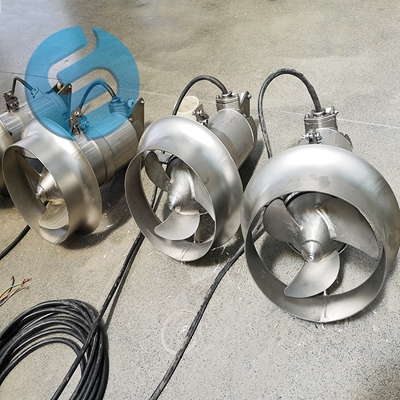There are various types of mixers commonly used in sewage treatment plants to meet the needs of different treatment stages and processes. Common types of mixers include, but are not limited to, the following:
1. Push mixer
Features: Propulsion mixers usually have a powerful mixing effect and are suitable for large-scale wastewater treatment plants. The impeller design can produce a large flow pushing effect, which helps to promote the uniform distribution of suspended matter in sewage.
Application: In areas such as oxidation ditches and anoxic pools, propulsion mixers are often used as the main mixing equipment to ensure that microorganisms in sewage are in full contact with organic matter and improve treatment efficiency.

2. Paddle mixer
Features: Paddle mixer has simple structure, easy maintenance, and is suitable for small sewage treatment facilities. The stirring blades are usually arranged horizontally or tilted, and the stirring effect is generated by rotation.
Application: Paddle mixer is widely used in the regulating pool and reaction pool of small sewage treatment plant. They can effectively mix suspended substances and chemicals in sewage and promote chemical reactions.
3. Turbo mixer
Features: The turbine mixer has strong shear force, which is suitable for treating high concentration sewage. The complex design of the mixing blade can produce strong eddy currents and shear forces, which help to break the colloidal and particle structures in the sewage.
Application: In the sewage treatment process requiring high intensity mixing, such as coagulation, flocculation and other stages, turbine mixer is often chosen. They can ensure that the reagent is fully mixed with the sewage and improve the treatment effect.
4. Screw mixer
Features: Screw mixer has the characteristics of uniform mixing and low energy consumption, which is suitable for treating organic wastewater. The stirring mechanism mixes and transmits sewage and sludge through the rotation of screw.
Application: In anaerobic digestion tank, sludge thickening tank and other areas, screw mixers are often used to promote sludge mixing and transportation, improve treatment efficiency and stability.
5. Submersible mixer
Features: Submersible mixer, also known as submersible mixer, is suitable for the process of sewage treatment plants. They can be submerged and stirred directly without the need for additional gearing and sealing devices. Submersible mixer has the advantages of low energy consumption, high efficiency and easy maintenance.
Application: In aeration tanks, anaerobic tanks and other areas, submersible mixers are widely used to promote the mixing of sewage and sludge, prevent sludge settlement, and generate the necessary water flow and process flow field.
6. Stand mixer
Features: The vertical mixer is usually installed above the pool in the coagulation and flocculation stage, and the motor is located on the water surface. They stir the sewage through vertically mounted stirring blades, promoting the formation and settlement of flocs.
Application: In the sewage treatment process that needs to accurately control the mixing speed and mixing effect, such as coagulation and precipitation, deep treatment and other stages, vertical mixers are often chosen.
In summary, there are many types of mixers commonly used in sewage treatment plants, and the specific selection should be comprehensively considered according to the treatment process, treatment scale, water quality characteristics and equipment performance. In practical applications, it may be necessary to combine the advantages and characteristics of multiple mixers to meet the complex needs of wastewater treatment plants.
Post time:2024-07-15